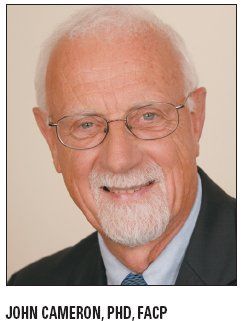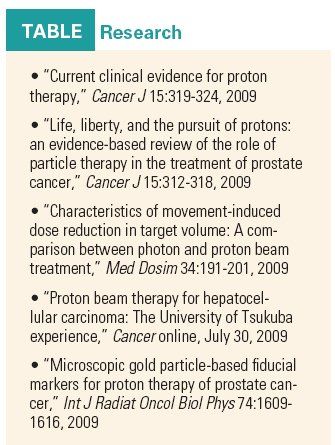Proton-beam therapy calls for unique skills
The first proton-beam therapy center in Loma Linda, Calif., opened almost 20 years ago, and today six are operating in the U.S. Another center will open by the end of 2009 with several more planned in the next two years, including centers in continental Europe and the UK. A growing body of research affirms the efficacy of proton-beam therapy (see Table).
The first proton-beam therapy center in Loma Linda, Calif., opened almost 20 years ago, and today six are operating in the U.S. Another center will open by the end of 2009 with several more planned in the next two years, including centers in continental Europe and the UK. A growing body of research affirms the efficacy of proton-beam therapy (see Table). Special sessions on proton-beam therapy (also known as proton therapy) are being organized by ASTRO, the American Association of Physicists in Medicine, and the Particle Therapy Co-Operative Group.

With affirmation comes demand: The six operational centers in the U.S. now treat about 5,000 patients per year. As we continue to test and expand the use of protons, the demand for skilled medical professionals will most certainly grow, but hiring and training staff can be a challenge. Expertise in delivering traditional radiation therapy does not qualify an individual to deliver proton therapy. Proton therapy differs significantly in terms of treatment planning, patient positioning, and physics. The unique characteristics of protons require that careful attention be paid to professional development.
Qualified personnel
Ideally, proton-beam therapy is delivered by a team that includes:
• A radiation oncologist
• A radiation physicist
• A dosimetrist
• An immobilization specialist
• A radiation therapist
• A radiation therapy nurse
• A diagnostic radiologist
The radiation oncologist determines the tumor location and therapeutic course, working with the physicist, dosimetrist, and radiation therapist to establish the best way to deliver the prescribed treatment. The physicist and dosimetrist render detailed treatment calculations. Radiation therapists perform the daily radiation treatments. Radiologists are called on to read pre- and post-therapy imaging studies. Last but not least, nurses help manage the side effects of the treatment. With the exception of the radiologists, all of these specialists could qualify for training in proton therapy. While there is some overlap between the specialties in training, a legitimate educational course will tailor the materials accordingly.
Technical demands
Compared with standard photon treatment, proton therapy allows for an increased radiation dose to a tumor while reducing the amount of radiation deposited in the healthy tissue surrounding it. Protons can control and eliminate tumors in much the same way as standard radiation but with fewer short- and long-term side effects, including fewer secondary tumors.

There is currently no official certification for proton radiation therapy. It is also not covered in most radiation therapy training programs. Yet the technical demands of correctly delivering proton therapy make training essential. For example, when the proton beam stops at a well-defined depth, this greatly impacts the treatment plan calculations done by the dosimetrist. The increased precision of proton therapy requires greater attention to positioning of the patient by the radiation technician.
Training sites
The Midwest Proton Radiotherapy Institute (MPRI) at Indiana University in Bloomington treated its first patient in 2004. The MPRI and Bloomington’s Ivy Tech Community College and ProCure Training and Development Center are working jointly on a certificate program for proton therapy. Larry Swafford, PhD, a professor and chair of the radiation therapy program at Ivy Tech, is spearheading the project.
The training program at ProCure offers a template of what a future certification will require. Training sessions range from 11 to 17 weeks and include didactic lectures; hands-on training in equipment, software, and hardware; and the operation of the simulators. The lectures cover proton development, management training, and patient treatment modalities. The full course does require in-person attendance, although some of it can be done through distance education classes and online-accessible models.
Challenges ahead
As with any new technology, proton therapy must address some growing pains. Training staff is difficult unless there are enough qualified instructors. For small proton therapy centers to become a reality, there needs to be a reduction in the size and costs of the proton therapy systems that are commercially available. Fortunately, equipment suppliers are moving in that direction, with technical innovations to accelerators and beam delivery systems.
Proton therapy centers in the U.S. only treat about 6,000 patients a year, which means they have to turn away more patients than they can accept. The same rigorous education standards that exist for other radiation-based modalities need to be in place to ensure the proper delivery of proton therapy.
Newsletter
Stay up to date on recent advances in the multidisciplinary approach to cancer.
Elevating the Quality of Cancer Care via Cross-Department Collaboration
Experts from Sibley Memorial Hospital discuss how multidisciplinary work has enhanced outcomes such as survival and resource use at their institution.